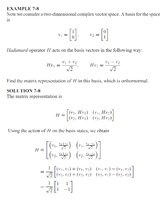You are using an out of date browser. It may not display this or other websites correctly.
You should upgrade or use an alternative browser.
You should upgrade or use an alternative browser.
Orthonormal Basis
- Thread starter nasi112
- Start date
The notation [MATH](\boldsymbol{a},\boldsymbol{b})[/MATH] represents the 'dot product', i.e. [MATH]\boldsymbol{a}.\boldsymbol{b}[/MATH]Now [MATH]\boldsymbol{v_1}.\boldsymbol{v_1}=\binom{1}{0}.\binom{1}{0}=1[/MATH]and [MATH]\boldsymbol{v_1}.\boldsymbol{v_2}=\binom{1}{0}.\binom{0}{1}=0[/MATH]so e.g. [MATH]\left(\boldsymbol{v_1},\frac{\boldsymbol{v_1}+\boldsymbol{v_2}}{\sqrt{2}} \right) = \boldsymbol{v_1}. \frac{1}{\sqrt{2}}(\boldsymbol{v_1}+\boldsymbol{v_2})=\frac{1}{\sqrt{2}}\boldsymbol{v_1}.(\boldsymbol{v_1}+\boldsymbol{v_2})= \frac{1}{\sqrt{2}}(\boldsymbol{v_1}.\boldsymbol{v_1}+\boldsymbol{v_1}.\boldsymbol{v_2})=\frac{1}{\sqrt{2}}(1+0)=\frac{1}{\sqrt{2}}[/MATH]
In fact you can easily write down the matrix representation directly from this line:

The first column is just what [MATH]\boldsymbol{v_1}[/MATH] is mapped to (in terms of the basis vectors): [MATH] \begin{pmatrix} \frac{1}{\sqrt{2}}\\ \frac{1}{\sqrt{2}} \end{pmatrix}[/MATH]
The second column is just what [MATH]\boldsymbol{v_2}[/MATH] is mapped to (in terms of the basis vectors): [MATH] \begin{pmatrix} \frac{1}{\sqrt{2}}\\ -\frac{1}{\sqrt{2}} \end{pmatrix}[/MATH]
So the matrix for H is:
[MATH] \begin{pmatrix} \frac{1}{\sqrt{2}} &&\frac{1}{\sqrt{2}}\\ \frac{1}{\sqrt{2}} && -\frac{1}{\sqrt{2}} \end{pmatrix}[/MATH]
or
[MATH]\tfrac{1}{\sqrt{2}} \begin{pmatrix} 1 && 1\\ 1 && -1\\ \end{pmatrix}[/MATH]
In fact you can easily write down the matrix representation directly from this line:
The first column is just what [MATH]\boldsymbol{v_1}[/MATH] is mapped to (in terms of the basis vectors): [MATH] \begin{pmatrix} \frac{1}{\sqrt{2}}\\ \frac{1}{\sqrt{2}} \end{pmatrix}[/MATH]
The second column is just what [MATH]\boldsymbol{v_2}[/MATH] is mapped to (in terms of the basis vectors): [MATH] \begin{pmatrix} \frac{1}{\sqrt{2}}\\ -\frac{1}{\sqrt{2}} \end{pmatrix}[/MATH]
So the matrix for H is:
[MATH] \begin{pmatrix} \frac{1}{\sqrt{2}} &&\frac{1}{\sqrt{2}}\\ \frac{1}{\sqrt{2}} && -\frac{1}{\sqrt{2}} \end{pmatrix}[/MATH]
or
[MATH]\tfrac{1}{\sqrt{2}} \begin{pmatrix} 1 && 1\\ 1 && -1\\ \end{pmatrix}[/MATH]
Last edited:

